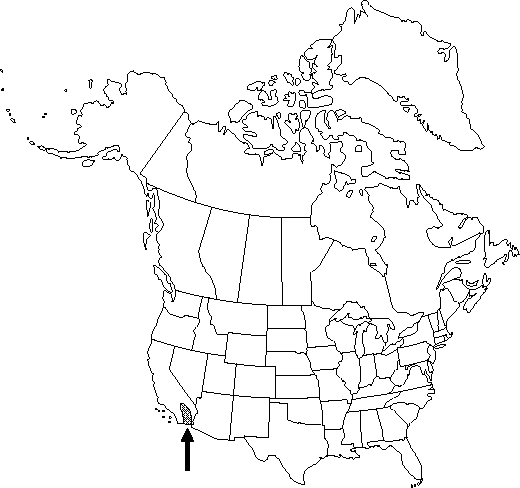Difference between revisions of "Eschscholzia parishii"
Bull. Calif. Acad. Sci. 1: 183. 1885.
FNA>Volume Importer |
FNA>Volume Importer |
||
| Line 16: | Line 16: | ||
}}<!-- | }}<!-- | ||
| − | --><span class="statement" id="st- | + | --><span class="statement" id="st-undefined" data-properties=""><b>Plants </b>annual, caulescent, erect, 5-30 cm. <b>Leaves</b> basal and cauline; blade bright green or yellow-green, glabrous; ultimate lobes obtuse except terminal one slender, acute. <b>Inflorescences</b> cymose or 1-flowered; buds nodding. <b>Flowers</b>: receptacle obconic, cup without spreading free rim; calyx apiculate, glabrous, sometimes glaucous; petals yellow, 15-30 mm. <b>Capsules</b> 5-7 cm. <b>Seeds</b> tan to brown, spheric to ellipsoid, 1-1.4 mm, reticulate. <b>2n</b> = 12.</span><!-- |
-->{{Treatment/Body | -->{{Treatment/Body | ||
| Line 22: | Line 22: | ||
|habitat=Desert slopes, hillsides | |habitat=Desert slopes, hillsides | ||
|elevation=0-1200 m | |elevation=0-1200 m | ||
| − | |distribution=Calif.;Mexico (Baja California and Sonora) | + | |distribution=Calif.;Mexico (Baja California and Sonora). |
|discussion=<p>Plants of the El Paso and Rand mountains in the western Mojave Desert that have been referred to this species are Eschscholzia minutiflora.</p><!-- | |discussion=<p>Plants of the El Paso and Rand mountains in the western Mojave Desert that have been referred to this species are Eschscholzia minutiflora.</p><!-- | ||
--><p>The Kawaiisu used Eschscholzia parishii medicinally to treat venereal sores, gonorrhea, and syphilis (D. E. Moerman 1986).</p> | --><p>The Kawaiisu used Eschscholzia parishii medicinally to treat venereal sores, gonorrhea, and syphilis (D. E. Moerman 1986).</p> | ||
| Line 43: | Line 43: | ||
|habitat=Desert slopes, hillsides | |habitat=Desert slopes, hillsides | ||
|elevation=0-1200 m | |elevation=0-1200 m | ||
| − | |distribution=Calif.;Mexico (Baja California and Sonora) | + | |distribution=Calif.;Mexico (Baja California and Sonora). |
|reference=None | |reference=None | ||
|publication title=Bull. Calif. Acad. Sci. | |publication title=Bull. Calif. Acad. Sci. | ||
|publication year=1885 | |publication year=1885 | ||
|special status= | |special status= | ||
| − | |source xml=https://jpend@bitbucket.org/aafc-mbb/fna- | + | |source xml=https://jpend@bitbucket.org/aafc-mbb/fna-data-curation.git/src/9216fc802291cd3df363fd52122300479582ede7/coarse_grained_fna_xml/V3/V3_769.xml |
|genus=Eschscholzia | |genus=Eschscholzia | ||
|species=Eschscholzia parishii | |species=Eschscholzia parishii | ||
| − | |||
| − | |||
| − | |||
| − | |||
| − | |||
| − | |||
| − | |||
| − | |||
| − | |||
| − | |||
| − | |||
| − | |||
| − | |||
| − | |||
| − | |||
| − | |||
| − | |||
| − | |||
| − | |||
| − | |||
| − | |||
| − | |||
| − | |||
}}<!-- | }}<!-- | ||
-->[[Category:Treatment]][[Category:Eschscholzia]] | -->[[Category:Treatment]][[Category:Eschscholzia]] | ||
Revision as of 14:49, 27 July 2019
Plants annual, caulescent, erect, 5-30 cm. Leaves basal and cauline; blade bright green or yellow-green, glabrous; ultimate lobes obtuse except terminal one slender, acute. Inflorescences cymose or 1-flowered; buds nodding. Flowers: receptacle obconic, cup without spreading free rim; calyx apiculate, glabrous, sometimes glaucous; petals yellow, 15-30 mm. Capsules 5-7 cm. Seeds tan to brown, spheric to ellipsoid, 1-1.4 mm, reticulate. 2n = 12.
Phenology: Flowering spring (Mar–May).
Habitat: Desert slopes, hillsides
Elevation: 0-1200 m
Distribution

Calif., Mexico (Baja California and Sonora).
Discussion
Plants of the El Paso and Rand mountains in the western Mojave Desert that have been referred to this species are Eschscholzia minutiflora.
The Kawaiisu used Eschscholzia parishii medicinally to treat venereal sores, gonorrhea, and syphilis (D. E. Moerman 1986).
Selected References
None.